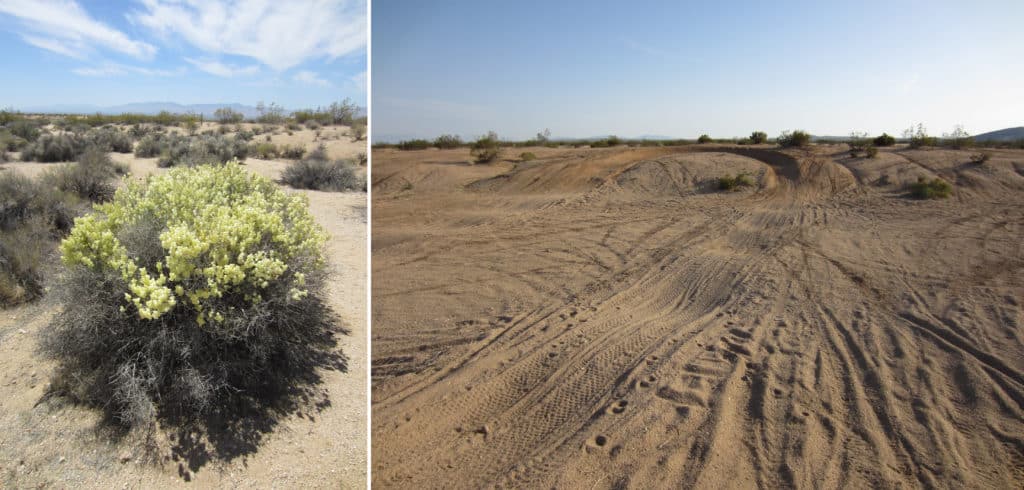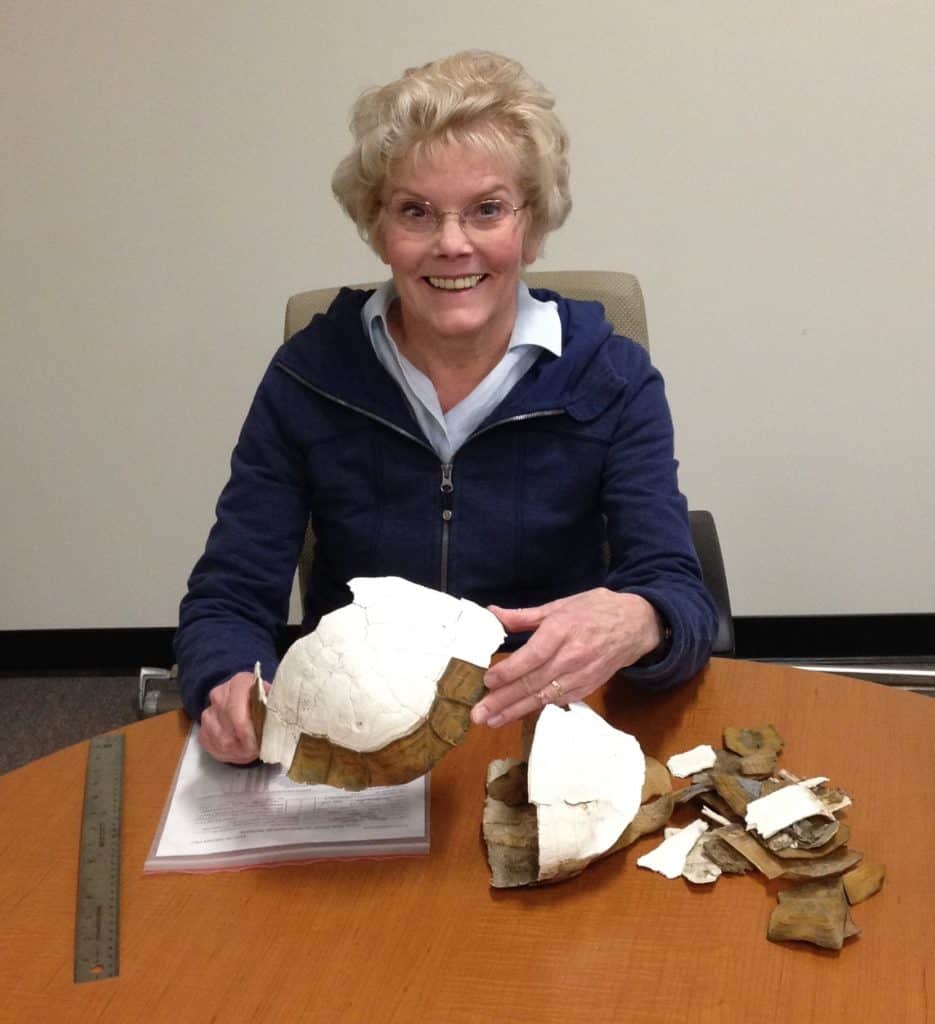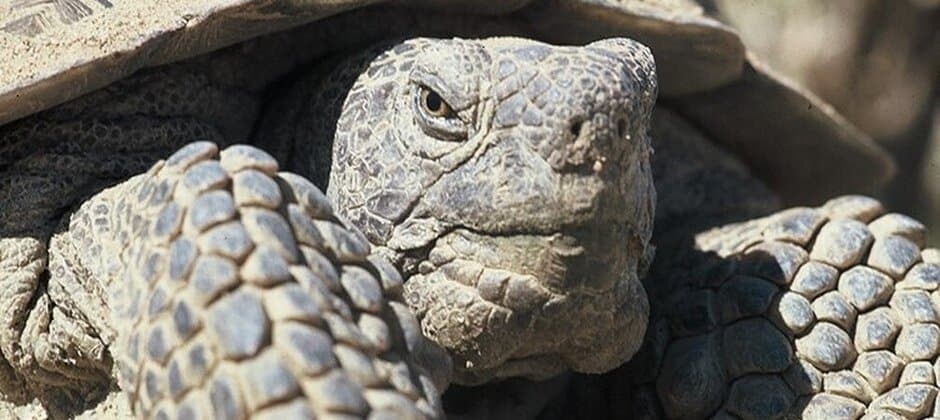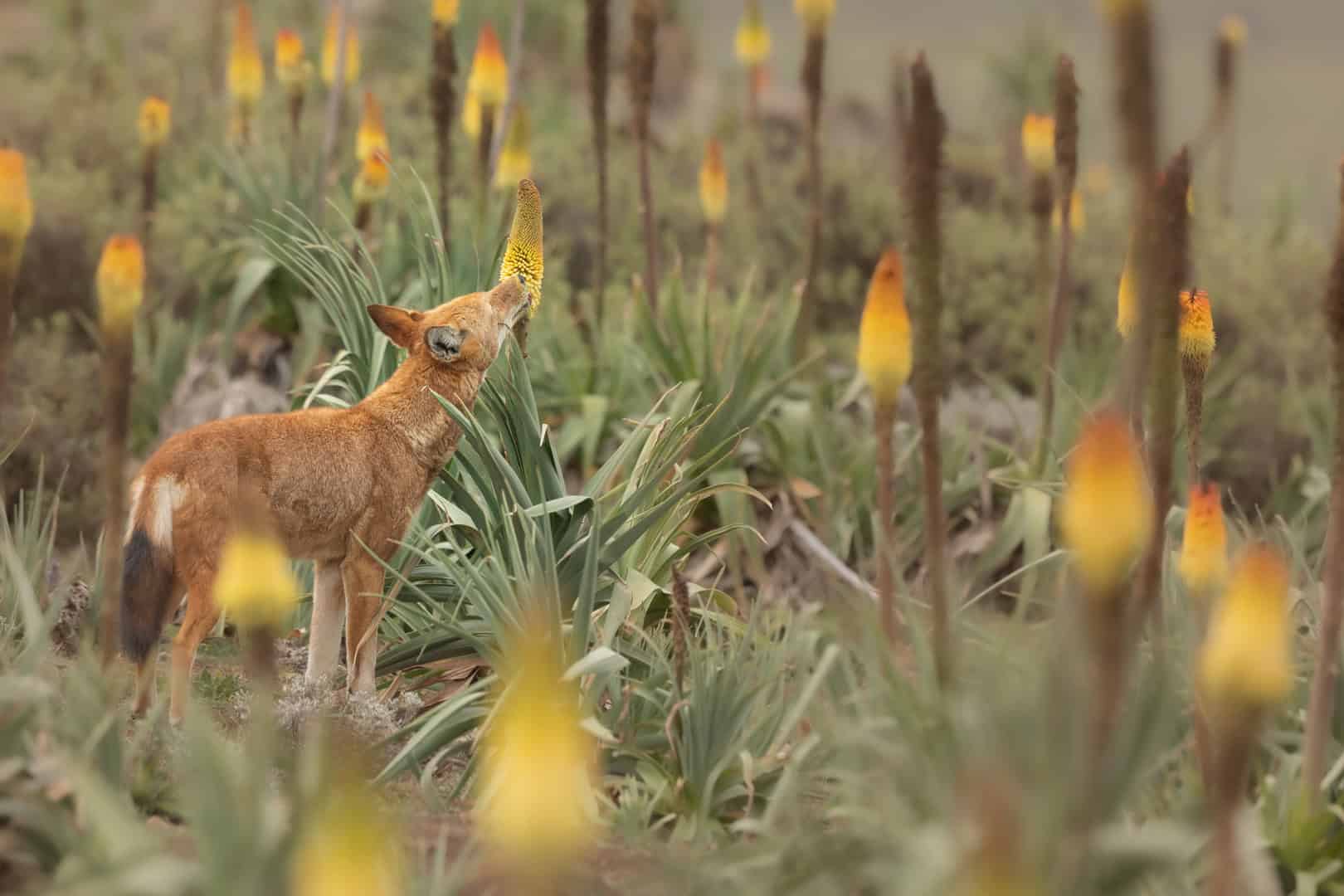Share this article
Fenced-in desert tortoises rebound after huge decline
Desert tortoises suffered a “catastrophic decline” over two decades due to habitat degradation, extensive predation, disease and a lack of sufficient protection, according to a new study.
But fencing to keep off-road vehicles from tearing up important habitat features for the reptiles has helped them rebound from the dangerously low levels they reached in the early 2000s.
“They’re doing a lot better inside the fence. Outside the fence, the habitat has very seriously degraded from off-road vehicles and sheep grazing,” said TWS member Kristin Berry, a principal investigator with the U.S. Geological Survey in wildlife biology research and the lead author of a Wildlife Monographs study published online in August.
Berry and her co-authors began the long-term study in 1978, before the Desert Tortoise Research Natural Area had been designated to conserve Agassiz’s desert tortoise (Gopherus agassizii) in the western Mojave Desert in California. While the 40-square mile area had already been outlined at the time, it wasn’t officially designated until 1980.
Just before the designation, a fence was erected around the area, raised off the ground so that the tortoises and other wildlife could pass while keeping off-road vehicles and domestic sheep out.

The photo on the left shows what the environment looks like inside the fenced tortoise area while the photo on the left shows the degraded environment outside. Credit: USGS
Off-road vehicles and trampling from grazing sheep can tear up shrubs and destroy burrows where the tortoises take refuge from the heat and lay their eggs. The vehicles compact the ground, making it difficult for tortoises to dig nests and create conditions that help invasive Mediterranean grasses thrive at the expense of native vegetation, which is much more nutritious for the herbivores. In the worst case, vehicles can strike and kill the large tortoises or destroy their nests. Some tortoises were even shot. Others had been or collected to be kept as pets.
The researchers counted 589 tortoises in 1978 before the fence was erected, marking them with notches so they could identify individuals. They also placed tags on their carapaces, in spots where they’re less likely to rub off when the reptiles went into their burrows.
“It was pretty exciting to mark that many tortoises,” Berry recalls. “[The tag] can last 10 years or more. If the animals die and you find the bodies, then you can sometimes find that tag and you can sometimes find notches and figure out who it was that died.”
The team picked out a three-square mile area, with some land inside the fence and some land outside the fence, to determine whether the measures were effective at tortoise conservation.
But by 1985, when the researchers conducted the first repeat survey of desert tortoises, they realized it would also be important to study vegetation and predation, because other researchers had identified ravens (Corvus corax) as preying heavily on the eggs and baby reptiles. Tom Campbell, the author of that study, had walked along the fence during his research counting dead baby tortoises. He found more than 150, Berry said.
Ravens have likely always preyed opportunistically on tortoises, but the desert ecosystem in the Mojave likely didn’t sustain so many of the corvids in the past. When settlers arrived, they brought trash, created roadkill and developed water sources. The raven population grew exponentially, leading to more incidental predation on juvenile tortoises.
“Raven populations grew because of us,” Berry said. “They have year-round water sources, year-round food.”
When Berry and her colleagues repeated the survey again in 1989, the situation looked even grimmer. An upper respiratory tract disease later found to be caused by the Mycoplasma agassizii pathogen was killing a number of tortoises. The disease, similar to pneumonia in humans, can kill Agassiz’s tortoises, and was first identified in captive turtles. Berry said it likely was transmitted to the wild population when people released tortoises they had taken illegally from the wild and held in captivity with other species of reptiles.
“It’s related to bad human behavior,” she said. She published research in the Journal of Wildlife Management in 2015 that showed the disease was more prevalent in tortoise populations closer to human populations.
In one of only two areas protected for the tortoise, ravens, sheep, off-road vehicles and now a deadly disease posed threats to a species that was already vulnerable. In only a decade, the population at the Desert Tortoise Research Natural Area had crashed.
“By 1989, we knew we had a crisis in hand,” Berry said.

Study author Kristin Berry examines a tortoise shell. Credit: Ray Butler
The U.S. Fish and Wildlife Service agreed, listing the species as threatened in 1990, but by 1993 there were only an estimated 95 animals left in this area. By 2002, this number was sliced in half to 47.
Desert tortoises are long lived, taking up to 25 years to reach sexual maturity. And for the first few years, the females don’t produce as many eggs as when they get older, when large ones can produce 10 to 15 eggs per year (though they don’t produce when years are particularly dry). Juvenile survival is also quite low.
“When the population density gets very low, it’s hard to recover,” Berry said.
In more recent years, the population has recovered a little from the 2002 low, likely bolstered by the protection from the fence. The last survey conducted in 2012 found 73 turtles. But the fenced area made a huge difference — 60 of those turtles were inside, while only 13 were found outside. Some of the tortoises that lived outside the protected area had moved in, possibly after nests or burrows were destroyed. The fenced area surveyed was larger than the part outside, though, but in terms of density per square kilometer, the inside area still had three times the number of tortoises than the outside.
For Berry, the take-home message is how critical this fence and others like it are for the conservation of Agassiz’s desert tortoises.
“An intact habitat is incredibly important,” she said.
The Red Cliffs Desert Reserve in the Upper Virgin River Recovery Unit in Utah, the only other protected, fenced area for the tortoises, experienced a wildfire in 2020 after burning just 15 years earlier in 2005. Tortoises were killed directly in the fires, and after the burn, Berry said, the tortoises lack the thermal protection that shrubs provide. Plus, their main source of food disappears for at least several years.
The Red Cliffs area is also under threat of being divided by a proposed highway. While the county pushing for the stretch of highway proposed increasing part of the tortoise reserve, the road would cut through part of the existing reserve. The application published by the Bureau of Land Management noted that the county anticipated some incidental tortoise deaths from the road.
“The proposed highway through this very small and sensitive reserve is a matter of great concern,” Berry said, because so much of the habitat has been burned and the threat of fires from cars.
Other research shows that fencing that blocks tortoises from the road may actually endanger the animals due to overheating as the reptiles pace the fence looking for a way through, though Berry noted the benefits of this likely outweigh the possible negative impacts.
“Viable tortoise populations cannot be sustained when habitat deteriorates or is fragmented into multiple, small patches by anthropogenic activities,” Berry and her co-authors said in the recent study.
The situation for desert tortoises is grimmer outside of these two protected areas, including the Mojave Desert, where invasive Sahara mustard has followed the creation of a solar facility, muscling out native plants the tortoises depend on.
“They stirred up a lot of ground, and the result was they inadvertently brought in a plant that wasn’t in this part of the Mojave naturally,” she said.
Despite a slight rebound in the Desert Tortoise Research Natural Area, the tortoises continue to decline at a fast rate across their distribution overall, according to a USFWS report that tracked the reptiles from 2004 to 2014.
To stop the declines, Berry and her co-authors said that tortoises would benefit from removal of ravens, better control of off-road vehicle recreation, and legal enforcement of collections of tortoises for pets and the pet trade. Tortoises would also benefit from habitat restoration. But the team acknowledges this may take centuries in some cases given the extent of the problem.
“The outlook for the desert tortoise appears bleak, especially if the downward population decline continues,” she said. “However, our nation has demonstrated amazing capacity for meeting difficult scientific and management challenges, and, if the will is there, the tortoise can be rescued from its current path to extinction.”
This article features research that was published in a TWS peer-reviewed journal. Individual online access to all TWS journal articles is a benefit of membership. Join TWS now to read the latest in wildlife research.
Header Image: An adult Agassiz’s desert tortoise. Credit: Kristin Berry








